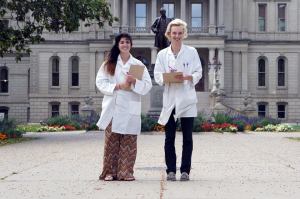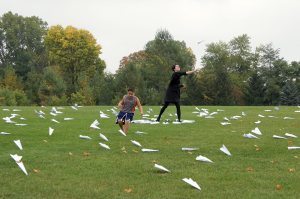It’s a well-known fact that art is often cross-cultural, but did you ever consider that an exhibit could be international?
“InterCIDADES,” originally a Brazilian exhibition became an international exhibition in October when it was brought to Lansing. For curator, Jefferson Kielwagen, this was a very exciting time.
“This is my first time doing anything on an international scale,” he said. “It’s an art exhibit, but in a way it’s a social experiment.”
The purpose of “InterCIDADES,” which translates to “inter” and “cities” in English, is to engage, captivate and “interchange” the community through relational art and public performance. Exhibitions included “Rolling Shadows,” a demonstration about solar energy and mobility, “Blood Fireworks,” an exhibition about food energy and “Inconvenience Station,” a study on the relationship between citizens and their city.

“Ponto de Inconveniência (Inconvenience Point),” by the Laborativo Collective, with Cody Sehl and Austin Lindeman in Lansing, Mich.
The curators of “InterCIDADES,” in conjunction with the Joinville Cultural Foundation and Schwanke Museum of Contemporary Art, sent out an open call for Brazilian and American artists to submit exhibition ideas. The aim was to gather projects that could be performed publicly in urban areas and re-performed internationally between Joinville, Brazil and Lansing, Mich.
“What made InterCIDADES appealing was the opportunity for artists’ work to be shown and executed on foreign grounds and the chance to engage with foreign artists,” he said.
In July of 2013, InterCIDADES took place in Brazil and throughout the month of October, it was re-created in Lansing. However, this was not the first time public performance was displayed in south central Michigan.
Kielwagen, who is also a third-year MFA student at MSU, proposed the idea to Michael Rush, Founding Director of the Eli and Edythe Broad Art Museum. In 2012, “The Broad Without Walls,” the first curated show at the Broad, was created in an attempt to engage the surrounding community prior to its completion. The exhibition followed through, but publicity was scarce.
“No one seemed to care about it. Then I came back from Brazil with the images [of “InterCIDADES” from July 2013] and everyone cared about it,” Kielwagen said.
At the beginning of Fall Semester 2013, MSU’s Department of Art, Art History and Design sent out an open call similar to the first open call released in Brazil.
As word spread, “InterCIDADES” began to ease its way into Michigan culture. However, there were a few speed bumps due to cultural differences.

Contrastes “Cuidadosamente Acentuados (Carefully Highlighted Contrasts),” by Priscila Dos Anjos, with Rebekah Blesing at Hawk Island County Park in Lansing, Mich.
Kielwagen brought “InterCIDADES” to America with hopes that our country could match the amount of money provided in Brazil for this project. He wanted to make it bigger and better, but failed to find funding on American grounds. The exhibitions were funded almost entirely by Joinville Cultural Foundation.
“Brazil is more socialist than the United States. Money for the arts is [mostly] government funded. American art seems to be focused on big names and big budgets. Museums often feel like bank vaults to me. Every gallery has a guard watching over the treasure. [It seems that] art is an object and the museum is the bank. I’m trying to make sense of this,” Kielwagen said.
Despite, the cultural differences, “InterCIDADES” was completed successfully with twice the amount of volunteers as before. It not only engaged the community and its participants, but it inspired.
Dylan Wahl, an electrical engineering major at MSU, thoroughly enjoyed his experience with the art world by getting involved with “InterCIDADES.” He wrote a script for “Trade Party,” an exhibition about the relationship between Brazil and the United States and also played a role in in “Rolling Shadows.”
Since InterCIDADES, Wahl began to create public performances of his own. “Parachute Run” and “Unboxing” are his two latest exhibitions about “an irrational dream of flight and the celebration of consumption as a public ritual,” he said.
“I have wanted for a while now to develop an artistic voice, and to learn more about how public art can be organized and structured,” Wahl said, “I hope that those who experienced the work in “InterCIDADES” feel inspired to seek out more public performance art.”
The future of “InterCIDADES” is a little uncertain, but hopeful. Kielwagen shared his hopes of making it a biannual, international event.
“I want to connect the farthest city in North America to the farthest city in South America. That would be Anchorage, Alaska (a.p. style?) and Ushuaia, Argentina. It would require the cooperation of two different governments so that might just be a crazy dream,” Kielwagen said.
If this followed through it would become the only biannual art exhibition not anchored in one city. Given its progress thus far, anything is possible for “InterCIDADES.”
Discussion
No comments yet.